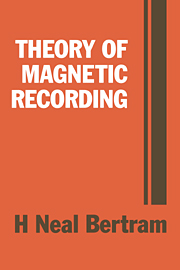Book contents
- Frontmatter
- Contents
- Preface
- 1 Overview
- 2 Review of magnetostatic fields
- 3 Inductive head fields
- 4 Medium magnetic fields
- 5 Playback process: Part 1 – General concepts and single transitions
- 6 Playback process: Part 2 – Multiple transitions
- 7 Magnetoresistive heads
- 8 Record process: Part 1 – Transition models
- 9 Record process: Part 2 – Non-linearities and overwrite
- 10 Medium noise mechanisms: Part 1 – General concepts, modulation noise
- 11 Medium noise mechanisms: Part 2 – Particulate noise
- 12 Medium noise mechanisms: Part 3 – Transition noise
- References and bibliography
- Index
11 - Medium noise mechanisms: Part 2 – Particulate noise
Published online by Cambridge University Press: 02 February 2010
- Frontmatter
- Contents
- Preface
- 1 Overview
- 2 Review of magnetostatic fields
- 3 Inductive head fields
- 4 Medium magnetic fields
- 5 Playback process: Part 1 – General concepts and single transitions
- 6 Playback process: Part 2 – Multiple transitions
- 7 Magnetoresistive heads
- 8 Record process: Part 1 – Transition models
- 9 Record process: Part 2 – Non-linearities and overwrite
- 10 Medium noise mechanisms: Part 1 – General concepts, modulation noise
- 11 Medium noise mechanisms: Part 2 – Particulate noise
- 12 Medium noise mechanisms: Part 3 – Transition noise
- References and bibliography
- Index
Summary
Introduction
The fundamental noise in magnetic recording is due to the granularity of the medium. If amplitude as well as phase modulation noise sources are not present, particulate noise remains. This noise can exhibit a different character in tapes than in thin films, because thin films have strong magnetic interactions and are densely packed. Nonetheless, particulate noise is basic to all recording media. The structure of this chapter will be to discuss first granularity noise neglecting particle correlations. The total noise power is simply a sum of the independent noise power from each particle or grain. Next, correlation effects are discussed that can involve spatial as well as magnetic correlations. A general formalism will be given, but only simple examples will be examined. The difficulty is that particulate noise modeling is based on Poisson statistics, which are valid only for point or infinitesimally small particles. The effects of finite particle size for moderately dilute systems, which leads to non-overlap effects, can only be included approximately. Granularity noise in thin films, where the grains are tightly packed, must be analyzed differently. A simple approach will be discussed in Chapter 12. In this chapter signal-tonoise ratios are estimated, and wherever appropriate, comparison will be made with the results for continuum fluctuations calculated in Chapter 10. The chapter begins with a calculation of the replay voltage pulse and spectrum of a single particle following previous analyses (Thurlings, 1980, 1983; Arratia & Bertram, 1984). A simplified model of particle clustering is presented at the end of this chapter. Only stationary correlations are discussed in this chapter. Non-stationary effects are the focus of Chapter 12.
- Type
- Chapter
- Information
- Theory of Magnetic Recording , pp. 283 - 305Publisher: Cambridge University PressPrint publication year: 1994



